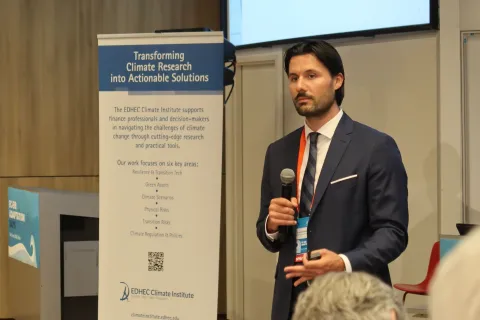EDHEC Co-Hosts Adaptation Days 2025 with EIB and European Commission During UN Ocean Conference

Hosted on 5–6 June at EDHEC’s Nice campus and online, the event brought together more than 200 participants from across sectors and institutions to explore a central question: How can climate-resilient coastal regions be financed in the context of increasing climate risks?
Through a combination of high-level ministerial dialogues and expert-led technical sessions, the programme facilitated cross-sectoral exchange, stakeholder engagement, and the identification of actionable strategies to strengthen adaptation planning and investment. The event also offered multiple opportunities for formal and informal discussion, including bilateral meetings and networking, both in-person and online.
Strengthening Coastal Resilience
Rising sea levels, driven by global warming, are intensifying the frequency and severity of storms, wave surges, and wind patterns. This leads to coastal erosion, flooding, and saltwater intrusion, posing mounting risks for millions of people worldwide. In this context, Adaptation Days 2025 served as a platform to explore solutions and investment strategies for enhancing the resilience of coastal infrastructure and communities.
The programme featured high-level ministerial dialogues and expert-led discussions. Among the keynote speakers we note:
- Emmanuel Métais, Dean, EDHEC Business School;
- Ambroise Fayolle, Vice-President, EIB;
- Kurt Vandenberghe, Director-General, DG CLIMA;
- Christian Estrosi, Mayor of Nice and President of Métropole Nice Côte d’Azur;
- Antony Derjacques, Minister for Transport, Seychelles; and
- Mirela Kumbaro Furxhi, Minister for Tourism and Environment, Albania.
Moderated by Lisa Burke (RTL Today, Luxembourg), the event offered an opportunity to align political leadership, science, and finance around a shared ambition for effective climate adaptation.

EDHEC Climate Institute Contributions
The EDHEC Climate Institute contributed actively to the technical agenda, presenting new research and applied tools to inform adaptation efforts.
Using Data for Better Adaptation Planning: A Coastal Climate Risk Perspective
During the opening keynote, Nicolas Schneider, macroeconomist and senior research engineer at EDHEC Climate Institute, delivered a compelling address on the imperative of leveraging granular climate data for adaptation planning in coastal regions. The session, titled "Using Data for Better Adaptation Planning – Absorption Capacity, Usability and Granularity", emphasised the heterogeneous nature of climate impacts and underscored the urgency of tailoring responses to regional vulnerabilities.

Nicolas framed the challenge around three pivotal questions:
- What is the localised size of future climate shocks?
- How much will adaptation cost?
- And who will bear this cost?
He highlighted the need of transitioning from global averages to localised data, enabling more precise modelling of physical climate risks – both acute (e.g. hurricanes) and chronic (e.g. long-term warming). The availability of high-resolution data and advances in computational capacity now make it possible to map these risks at administrative and even asset levels.
The presentation delved into key sectors including energy and agriculture. Rising temperatures are increasing summer electricity demands while decreasing winter gas use is stressing grid capacity. But adaptation responses – particularly electrification – can paradoxically exacerbate emissions. In agriculture, shifting temperatures threaten crop yields, with carbon fertilisation offering limited and uncertain offsets. Infrastructure too must be reassessed, especially in light of rising sea levels.
Nicolas stressed that granular climate data allows stakeholders – mayors, investors, insurers – to not only assess exposure but to translate risk into quantifiable economic implications. From estimating energy costs to forecasting GDP losses, such insights support smarter policy, pricing, and planning. He concluded with a clear message:
“Adaptation is no longer optional – it is necessary. Without granular data, adaptation funding remains misdirected. The time to act is now – because we finally can.”
Coastal Infrastructure and Climate Risk: Making Resilience Visible
On 6 June, Anthony Schrapffer, Scientific Director of the EDHEC Climate Institute, presented a climate risk map for coastal infrastructure, developed through EDHEC’s Scientific Climate Ratings (SCR) framework. His keynote introduced a pioneering approach to assessing climate risks across infrastructure assets, with a particular focus on coastal exposure.

Infrastructure is uniquely vulnerable to physical climate risks due to its long-term and immobile nature. Yet these risks are often underpriced and insufficiently quantified. The Institute addresses this gap through a dual-rating system:
- The Potential Climate Exposure Rating (PCER) measures future exposure to climate risks under a "continuity" policy scenario, with ratings ranging from A (least exposed) to G (most exposed).
- The Effective Climate Risk Rating (ECRR) quantifies the potential financial impact of climate hazards in Net Asset Value (NAV)-adjusted dollar terms, using multiple climate scenarios through 2035 and 2050.
The current SCR offering provides complimentary access to climate risk ratings for more than 6,000 infrastructure assets. Beginning in 2026, coverage will expand to include over 5,000 listed companies worldwide.
Coastal assets are of particular concern. Representing 23% of the global investable infrastructure base, they show a higher concentration of high-risk scores – especially due to storm and flood exposure. Assessing these risks requires both climate expertise and financial modelling.
A defining feature of the EDHEC methodology is its incorporation of resilience measures. Only documented, operational adaptation interventions are included in the ratings, ensuring methodological credibility and avoiding greenwashing. Supported by the EDHEC Climate Tech team, each sector’s adaptation potential is reviewed in detail. For example, Brisbane Airport saw a marked improvement in its flood and storm risk profile once its resilience measures were accounted for.
“Modelled on the logic of credit ratings, these climate risk assessments are designed to support investors, asset owners, and public authorities in making more informed, climate-aligned decisions. Visibility of resilience is key. We must not only assess vulnerability, but also recognise and reward efforts to adapt,” Anthony concluded.
Advancing Adaptation Through Collective Action
The EC-EIB Adaptation Days 2025 underscored the importance of collective action in the face of accelerating climate risks. Financing and implementing effective adaptation strategies require cooperation across sectors, disciplines, and governance levels. Building resilience is not only a technical and financial challenge – it is a societal one. As demonstrated throughout the event, aligning public and private actors, local authorities, civil society, and researchers is essential to develop innovative, inclusive, and scalable solutions. EDHEC Business School and the EDHEC Climate Institute are proud to contribute to this effort by advancing applied research and fostering dialogue among key stakeholders.

Access the More Resources
Session Replays from the Adaptation Days 2025:
EDHEC Climate Institute Presentations
- June 5 – Nicolas Schneider: Framing the Key Issues on Climate Adaptation and Coastal Climate Impacts
- June 6 – Anthony Schrapffer: Modelling financial value of coastal infrastructure at risk - A Scientific Rating Approach
Related EDHEC Research
- Global Average, Local Insights: Harnessing High-Resolution Data for Climate Risk Assessment
- Land and climate - the agricultural sector in a warming context
Scientific Climate Ratings
